Salby M.L. Fundamentals of Atmospheric Physics
Подождите немного. Документ загружается.

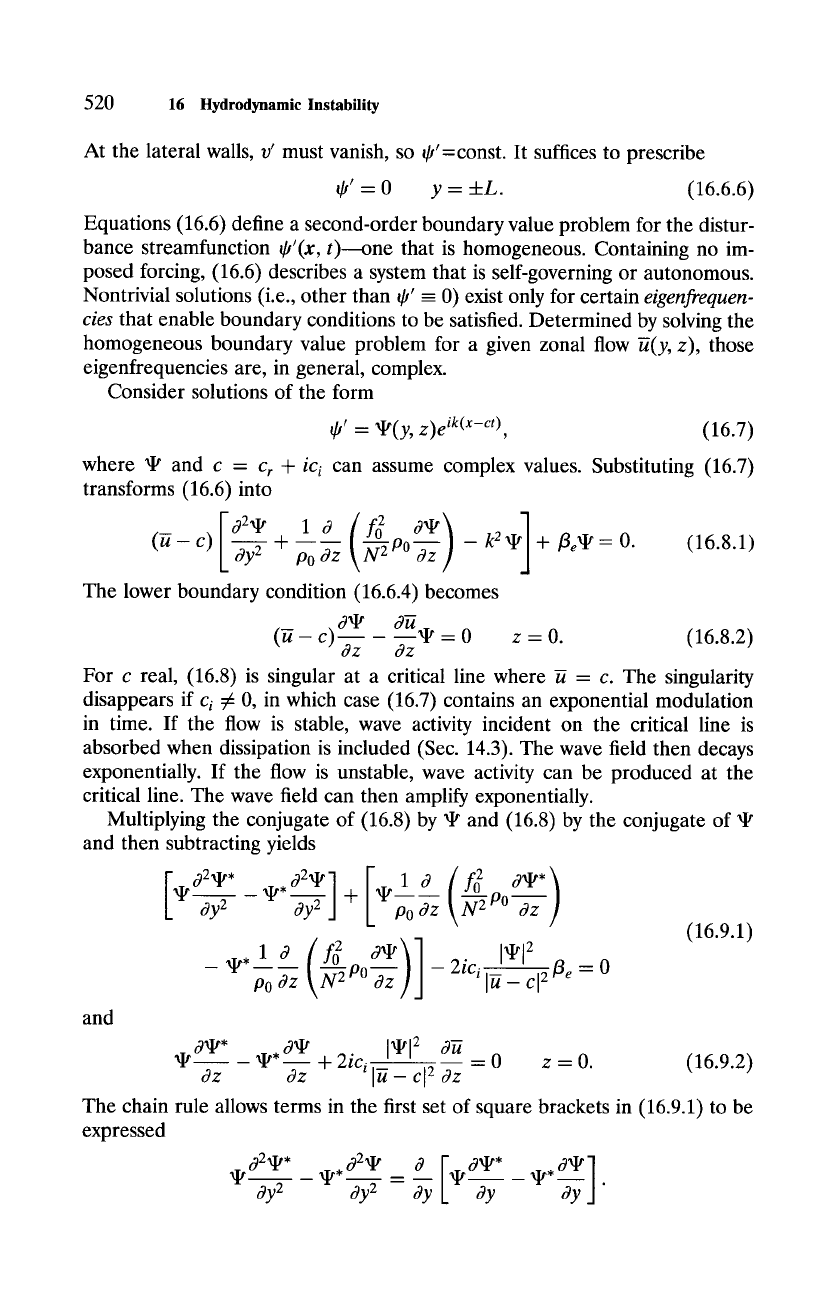
520
16
Hydrodynamic Instability
At the lateral walls, v' must vanish, so 0' =const. It suffices to prescribe
0' = 0 y - +L. (16.6.6)
Equations (16.6) define a second-order boundary value problem for the distur-
bance streamfunction ~'(x, t)--one that is homogeneous. Containing no im-
posed forcing, (16.6) describes a system that is self-governing or autonomous.
Nontrivial solutions (i.e., other than q,' -- 0) exist only for certain
eigenfrequen-
cies
that enable boundary conditions to be satisfied. Determined by solving the
homogeneous boundary value problem for a given zonal flow ~(y, z), those
eigenfrequencies are, in general, complex.
Consider solutions of the form
q,' = ~(y,
z)e ik(x-ct),
(16.7)
where 9 and
c - Cr +
ici
can
assume complex values. Substituting (16.7)
transforms (16.6) into
+ --P0 ~zz N2P~ - k2 +/~eXI t-- 0. (16.8.1)
The lower boundary condition (16.6.4)becomes
3~ 3~
(~- c)-- * - 0 z - 0. (16.8.2)
0z 3z
For c real, (16.8) is singular at a critical line where ~ = c. The singularity
disappears if
ci :/: O,
in which case (16.7) contains an exponential modulation
in time. If the flow is stable, wave activity incident on the critical line is
absorbed when dissipation is included (Sec. 14.3). The wave field then decays
exponentially. If the flow is unstable, wave activity can be produced at the
critical line. The wave field can then amplify exponentially.
Multiplying the conjugate of (16.8) by 9 and (16.8) by the conjugate of
and then subtracting yields
"u Oy---g--
ay 2 j + ~---- P0
po Oz kN 2 -~z
(16.9.1)
..10(, 0.)]
PO Oz N2 P o ~z - 2 i c i I -u -
c l
fie "-" 0
and
a~* _ ~, a~ I~] 2 3~ = 0 z - 0. (16.9.2)
3z 3z + 2ici [-u --
c[ 2 o~z
The chain rule allows terms in the first set of square brackets in (16.9.1) to be
expressed
02 XI/'* XI/'* o~2 a~r o ~ [~ o~aIt'* _ XI/'* o~aIr ]
,I, oy----- 7- - 07 = k oy
oy j
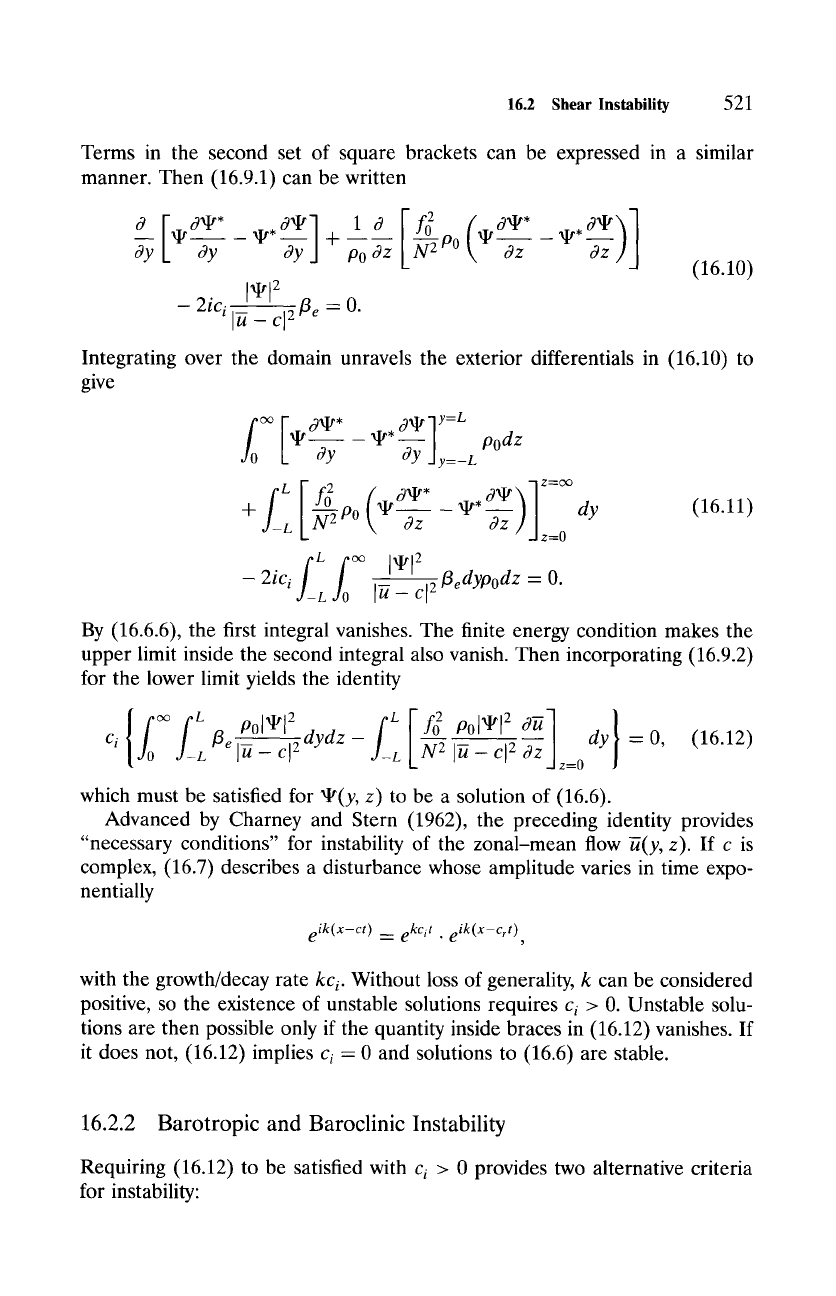
16.2 Shear
Instability
521
Terms in the second set of square brackets can be expressed in a similar
manner. Then (16.9.1) can be written
d I~d~*_xi,,O~ 1 10 [f~ (O~* ~,d~)l
3y L 3y 3y + ~ ~ -
Po 7z -~ Po az Oz
(16.10)
- 2ic i l_ ~
_ c[ 213 e -- O.
Integrating over the domain unravels the exterior differentials in (16.10) to
give
xI, 3xI't'* x[t* ~ y=L
- podz
'~Y aY y=-L
+ -~po Ve~--
L o~Z o~Z
z--O
2icifLfo0 ~L
I~I*12
{~._ C[ 2
~edypodz - O.
dy
(16.11)
By (16.6.6), the first integral vanishes. The finite energy condition makes the
upper limit inside the second integral also vanish. Then incorporating (16.9.2)
for the lower limit yields the identity
(16.12)
C i
/3 e ~P01XP'I2
dydz- ~ dy = O,
N 2 I-u cl 2 3z
L 1~- el 2 L -- ~--0
which must be satisfied for ~(y, z) to be a solution of (16.6).
Advanced by Charney and Stern (1962), the preceding identity provides
"necessary conditions" for instability of the zonal-mean flow K(y, z). If c is
complex, (16.7) describes a disturbance whose amplitude varies in time expo-
nentially
eik(x-ct) = ekci t . eik(x-Crt),
with the growth/decay
rate
kc i.
Without loss of generality, k can be considered
positive, so the existence of unstable solutions requires
ci
> 0. Unstable solu-
tions are then possible only if the quantity inside braces in (16.12) vanishes. If
it does not, (16.12) implies
ci
= 0 and solutions to (16.6) are stable.
16.2.2 Barotropic and Baroclinic Instability
Requiring (16.12) to be satisfied with
c i
>
0
provides two alternative criteria
for instability:
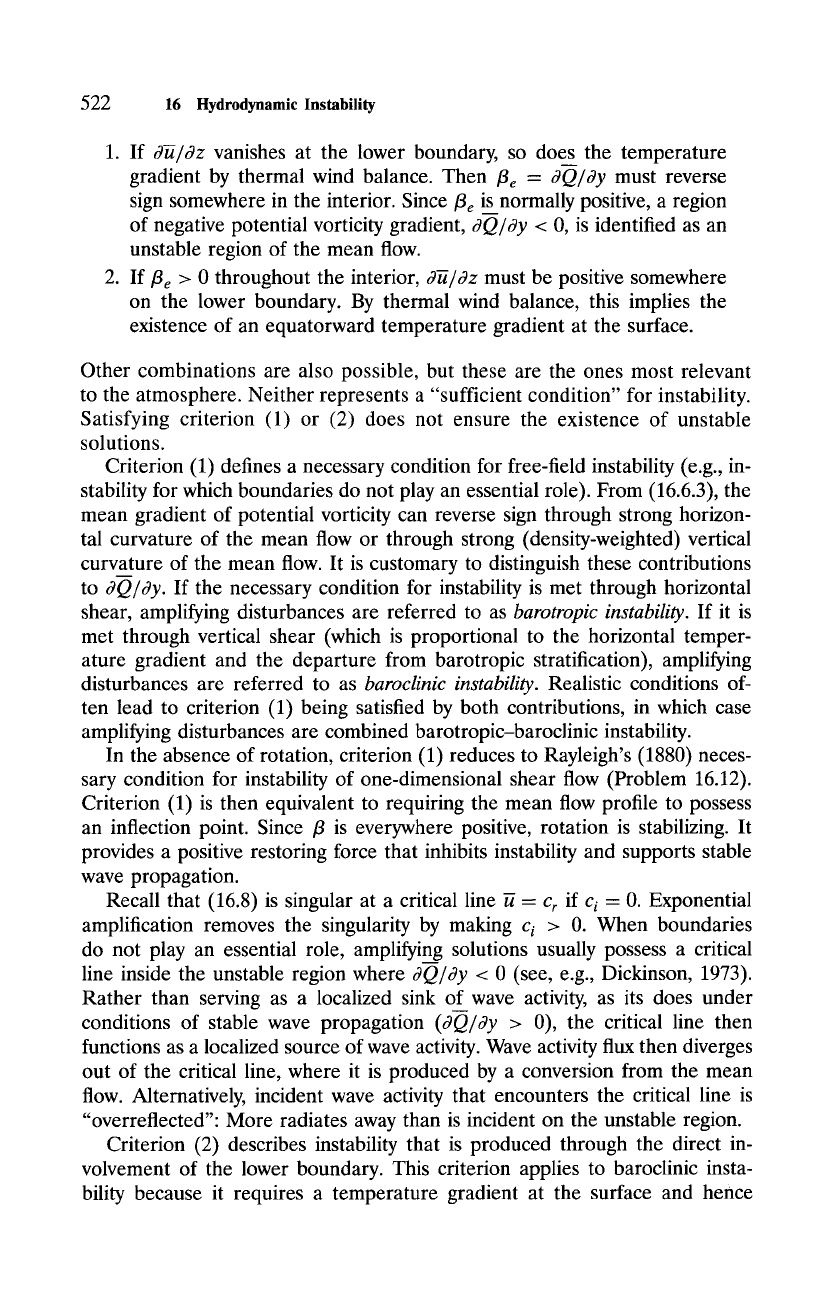
522
16 Hydrodynamic Instability
1. If
3-~13z
vanishes at the lower boundary, so does the temperature
gradient by thermal wind balance. Then /3e -
3Q/3y
must reverse
sign somewhere in the interior. Since/3 e isnormally positive, a region
of negative potential vorticity gradient,
oQ/3y
< 0, is identified as an
unstable region of the mean flow.
2. If/3 e > 0 throughout the interior,
3-u/3z
must be positive somewhere
on the lower boundary. By thermal wind balance, this implies the
existence of an equatorward temperature gradient at the surface.
Other combinations are also possible, but these are the ones most relevant
to the atmosphere. Neither represents a "sufficient condition" for instability.
Satisfying criterion (1) or (2) does not ensure the existence of unstable
solutions.
Criterion (1) defines a necessary condition for free-field instability (e.g., in-
stability for which boundaries do not play an essential role). From (16.6.3), the
mean gradient of potential vorticity can reverse sign through strong horizon-
tal curvature of the mean flow or through strong (density-weighted) vertical
curvature of the mean flow. It is customary to distinguish these contributions
to
eQ/3y.
If the necessary condition for instability is met through horizontal
shear, amplifying disturbances are referred to as
barotropic instability.
If it is
met through vertical shear (which is proportional to the horizontal temper-
ature gradient and the departure from barotropic stratification), amplifying
disturbances are referred to as
baroclinic instability.
Realistic conditions of-
ten lead to criterion (1) being satisfied by both contributions, in which case
amplifying disturbances are combined barotropic-baroclinic instability.
In the absence of rotation, criterion (1) reduces to Rayleigh's (1880) neces-
sary condition for instability of one-dimensional shear flow (Problem 16.12).
Criterion (1) is then equivalent to requiring the mean flow profile to possess
an inflection point. Since /3 is everywhere positive, rotation is stabilizing. It
provides a positive restoring force that inhibits instability and supports stable
wave propagation.
Recall that (16.8) is singular at a critical line K = Cr if
ci
= 0. Exponential
amplification removes the singularity by making
ci
> 0. When boundaries
do not play an essential role, amplifyin__g solutions usually possess a critical
line inside the unstable region where
~Q/~y
< 0 (see, e.g., Dickinson, 1973).
Rather than serving as a localized sink of wave activity, as its does under
conditions of stable wave propagation
(eQ/dy
> 0), the critical line then
functions as a localized source of wave activity. Wave activity flux then diverges
out of the critical line, where it is produced by a conversion from the mean
flow. Alternatively, incident wave activity that encounters the critical line is
"overreflected": More radiates away than is incident on the unstable region.
Criterion (2) describes instability that is produced through the direct in-
volvement of the lower boundary. This criterion applies to baroclinic insta-
bility because it requires a temperature gradient at the surface and hence
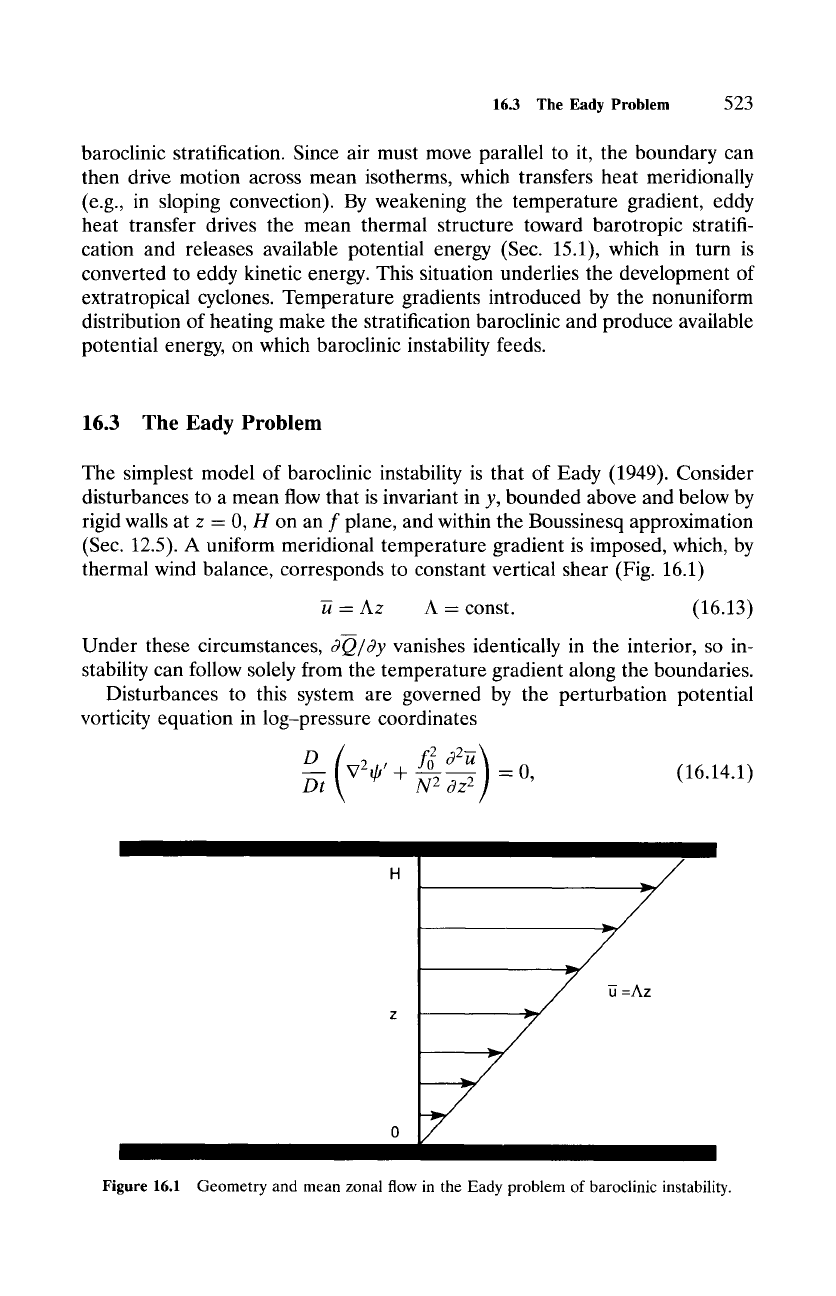
16.3 The Eady Problem
523
baroclinic stratification. Since air must move parallel to it, the boundary can
then drive motion across mean isotherms, which transfers heat meridionally
(e.g., in sloping convection). By weakening the temperature gradient, eddy
heat transfer drives the mean thermal structure toward barotropic stratifi-
cation and releases available potential energy (Sec. 15.1), which in turn is
converted to eddy kinetic energy. This situation underlies the development of
extratropical cyclones. Temperature gradients introduced by the nonuniform
distribution of heating make the stratification baroclinic and produce available
potential energy, on which baroclinic instability feeds.
16.3 The Eady Problem
The simplest model of baroclinic instability is that of Eady (1949). Consider
disturbances to a mean flow that is invariant in y, bounded above and below by
rigid walls at z = 0, H on an f plane, and within the Boussinesq approximation
(Sec. 12.5). A uniform meridional temperature gradient is imposed, which, by
thermal wind balance, corresponds to constant vertical shear (Fig. 16.1)
- Az A - const. (16.13)
n
Under these circumstances,
3Q/o~y
vanishes identically in the interior, so in-
stability can follow solely from the temperature gradient along the boundaries.
Disturbances to this system are governed by the perturbation potential
vorticity equation in log-pressure coordinates
D (v2~t'-4- f2 32-----~u)--O
(16.14.1)
Dt N 2 3z 2 '
=Az
Figure 16.1 Geometry and mean zonal flow in the Eady problem of baroclinic instability.
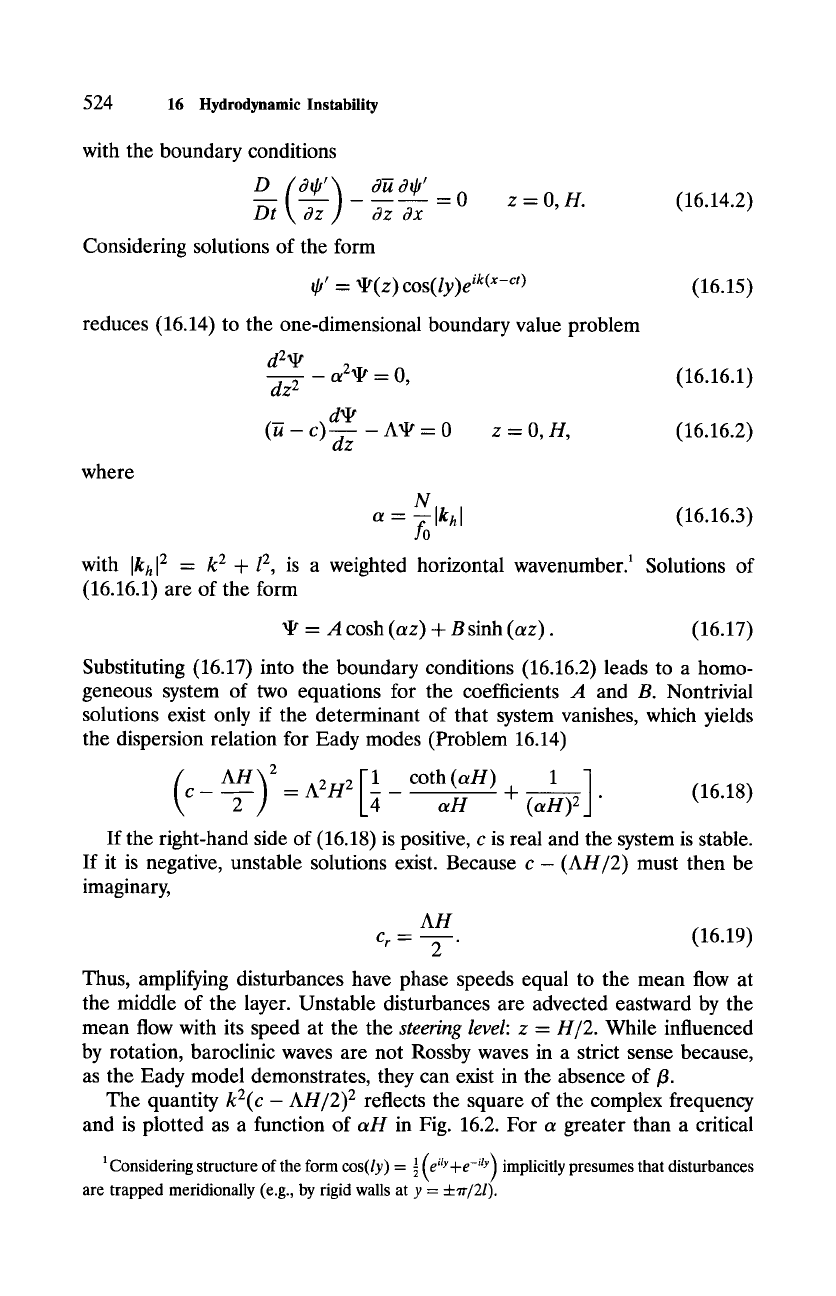
524 16
Hydrodynamic Instability
with the boundary conditions
D (3q/)
o~3q~'=O
z=O,H.
Dt ~ o~z 3x
Considering solutions of the form
~' = xIt(z) cos(ly)e ik(x-ct)
reduces (16.14) to the one-dimensional boundary value problem
d2~
-- a2a~ t = O,
dz 2
d~
(-~ - c)--~z - A ~ - 0 z = O, H,
where
(16.14.2)
(16:15)
(16.16.1)
(16.16.2)
N
a- ~lkhl
(16.16.3)
with [kh] 2
= k2-+ -/2,
is a weighted horizontal wavenumber. 1 Solutions of
(16.16.1) are of the form
= A cosh
(az) + B
sinh
(az).
(16.17)
Substituting (16.17) into the boundary conditions (16.16.2) leads to a homo-
geneous system of two equations for the coefficients A and B. Nontrivial
solutions exist only if the determinant of that system vanishes, which yields
the dispersion relation for Eady modes (Problem 16.14)
c = A2H2 coth
(all) 1
aH + (all) 2 . (16.18)
If the right-hand side of (16.18) is positive, c is real and the system is stable.
If it is negative, unstable solutions exist. Because c- (AH/2) must then be
imaginary,
AH
Cr
= --~-. (16.19)
Thus, amplifying disturbances have phase speeds equal to the mean flow at
the middle of the layer. Unstable disturbances are advected eastward by the
mean flow with its speed at the the
steering level: z = HI2.
While influenced
by rotation, baroclinic waves are not Rossby waves in a strict sense because,
as the Eady model demonstrates, they can exist in the absence of/3.
The quantity
k2(c-
AH/2) 2 reflects the square of the complex frequency
and is plotted as a function of aH in Fig. 16.2. For a greater than a critical
1( )
1Considering structure of the form cos(/y) = 5
eily+e -ily
implicitly presumes that disturbances
are trapped meridionally (e.g., by rigid walls at y =
•
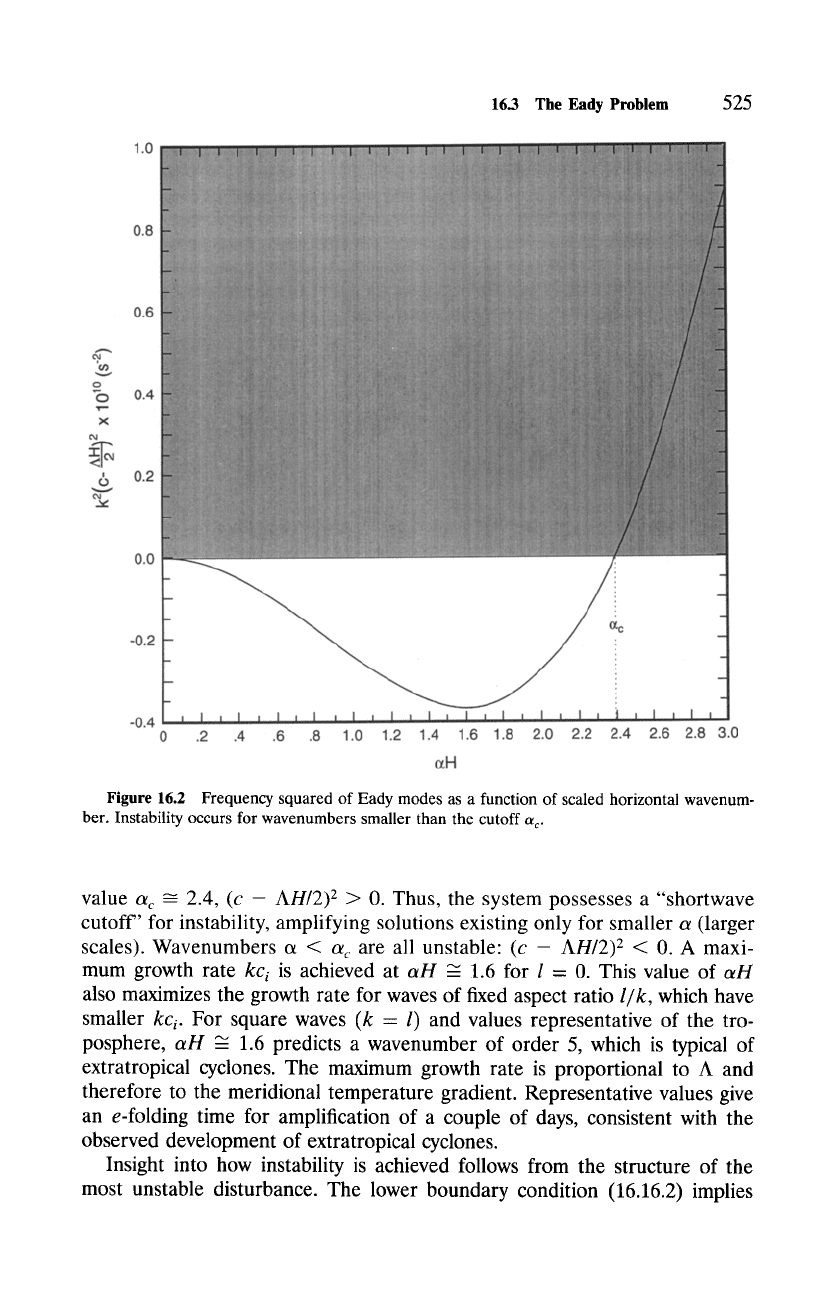
16.3 The Eady Problem
525
1.0
0.8
0.6
tat)
v
o
~:~ 0.4
T--
X
G
6 o.2
0.0
-0.2
-0.4
0 .2
Figure 16.2
ber. Instability occurs for wavenumbers smaller than the cutoff c~ c.
~c
.4 .6 .8 1.0 1.2 1.4 1.6 1.8 2.0 2.2 2.4 2.6 2.8 3.0
(zH
Frequency squared of Eady modes as a function of scaled horizontal wavenum-
value ac ~ 2.4, (c - AH/2) 2 > 0. Thus, the system possesses a "shortwave
cutoff' for instability, amplifying solutions existing only for smaller a (larger
scales). Wavenumbers oL < a~ are all unstable: (c - AH/2) 2 < 0. A maxi-
mum growth
rate
kc i
is achieved at
aH ~
1.6 for l - 0. This value of
aH
also maximizes the growth rate for waves of fixed aspect ratio
l/k,
which have
smaller
kci.
For square waves (k = l) and values representative of the tro-
posphere,
aH ~-
1.6 predicts a wavenumber of order 5, which is typical of
extratropical cyclones. The maximum growth rate is proportional to A and
therefore to the meridional temperature gradient. Representative values give
an e-folding time for amplification of a couple of days, consistent with the
observed development of extratropical cyclones.
Insight into how instability is achieved follows from the structure of the
most unstable disturbance. The lower boundary condition (16.16.2) implies
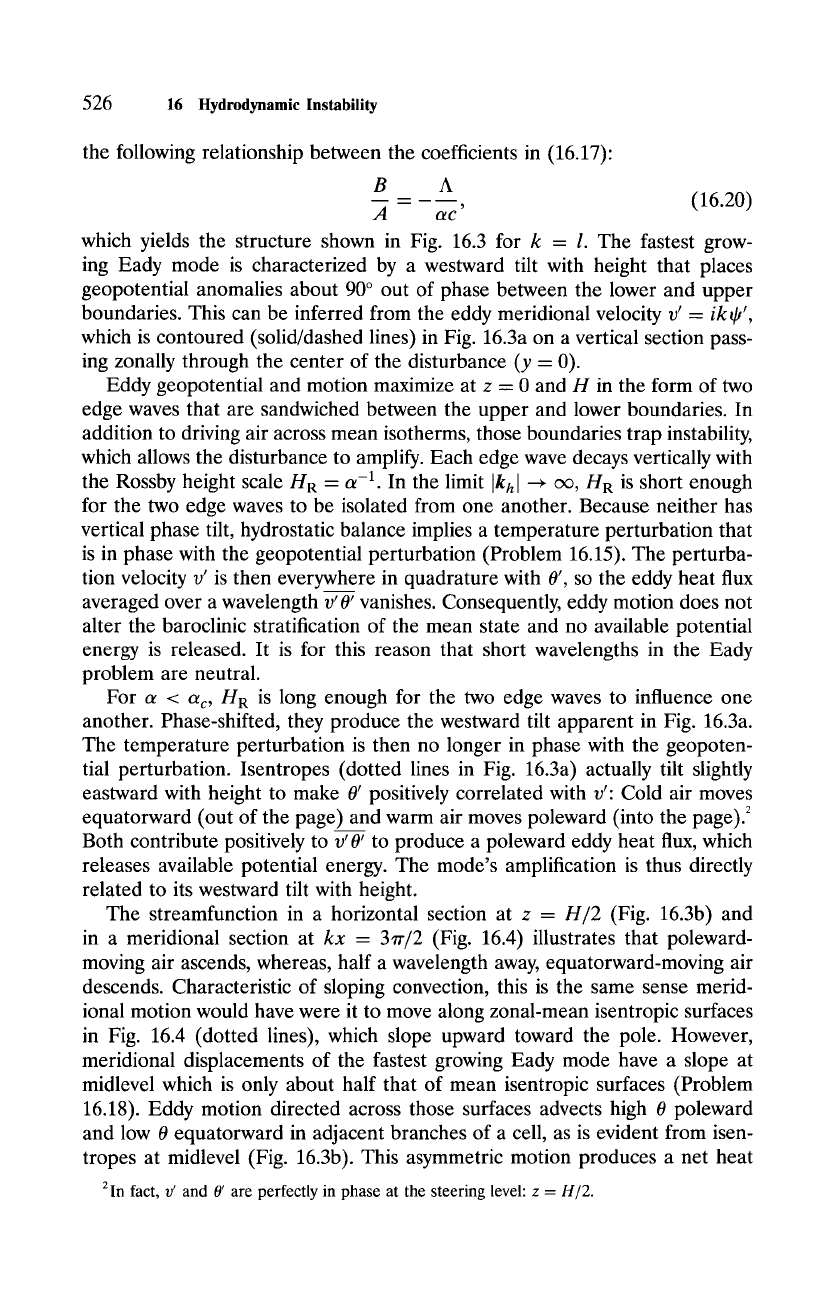
526
16
Hydrodynamic Instability
the following relationship between the coefficients in (16.17):
B A
= (16.20)
A c~c'
which yields the structure shown in Fig. 16.3 for k - l. The fastest grow-
ing Eady mode is characterized by a westward tilt with height that places
geopotential anomalies about 90 ~ out of phase between the lower and upper
boundaries. This can be inferred from the eddy meridional velocity v' =
ikq/,
which is contoured (solid/dashed lines) in Fig. 16.3a on a vertical section pass-
ing zonally through the center of the disturbance (y - 0).
Eddy geopotential and motion maximize at z = 0 and H in the form of two
edge waves that are sandwiched between the upper and lower boundaries. In
addition to driving air across mean isotherms, those boundaries trap instability,
which allows the disturbance to amplify. Each edge wave decays vertically with
the Rossby height scale H R - a-1. In the limit
Ikhl --+ c~, H R
is short enough
for the two edge waves to be isolated from one another. Because neither has
vertical phase tilt, hydrostatic balance implies a temperature perturbation that
is in phase with the geopotential perturbation (Problem 16.15). The perturba-
tion velocity v' is then everywhere in quadrature with 0', so the eddy heat flux
averaged over a wavelength v' 0' vanishes. Consequently, eddy motion does not
alter the baroclinic stratification of the mean state and no available potential
energy is released. It is for this reason that short wavelengths in the Eady
problem are neutral.
For a <
a c, H R
is long enough for the two edge waves to influence one
another. Phase-shifted, they produce the westward tilt apparent in Fig. 16.3a.
The temperature perturbation is then no longer in phase with the geopoten-
tial perturbation. Isentropes (dotted lines in Fig. 16.3a) actually tilt slightly
eastward with height to make 0' positively correlated with v" Cold air moves
equatorward (out of the page) and warm air moves poleward (into the page). 2
Both contribute positively to v' 0' to produce a poleward eddy heat flux, which
releases available potential energy. The mode's amplification is thus directly
related to its westward tilt with height.
The streamfunction in a horizontal section at
z - H/2
(Fig. 16.3b) and
in a meridional section at
kx -
37r/2 (Fig. 16.4) illustrates that poleward-
moving air ascends, whereas, half a wavelength away, equatorward-moving air
descends. Characteristic of sloping convection, this is the same sense merid-
ional motion would have were it to move along zonal-mean isentropic surfaces
in Fig. 16.4 (dotted lines), which slope upward toward the pole. However,
meridional displacements of the fastest growing Eady mode have a slope at
midlevel which is only about half that of mean isentropic surfaces (Problem
16.18). Eddy motion directed across those surfaces advects high 0 poleward
and low 0 equatorward in adjacent branches of a cell, as is evident from isen-
tropes at midlevel (Fig. 16.3b). This asymmetric motion produces a net heat
2 In fact, v' and 0' are perfectly in phase at the steering level: z =
HI2.
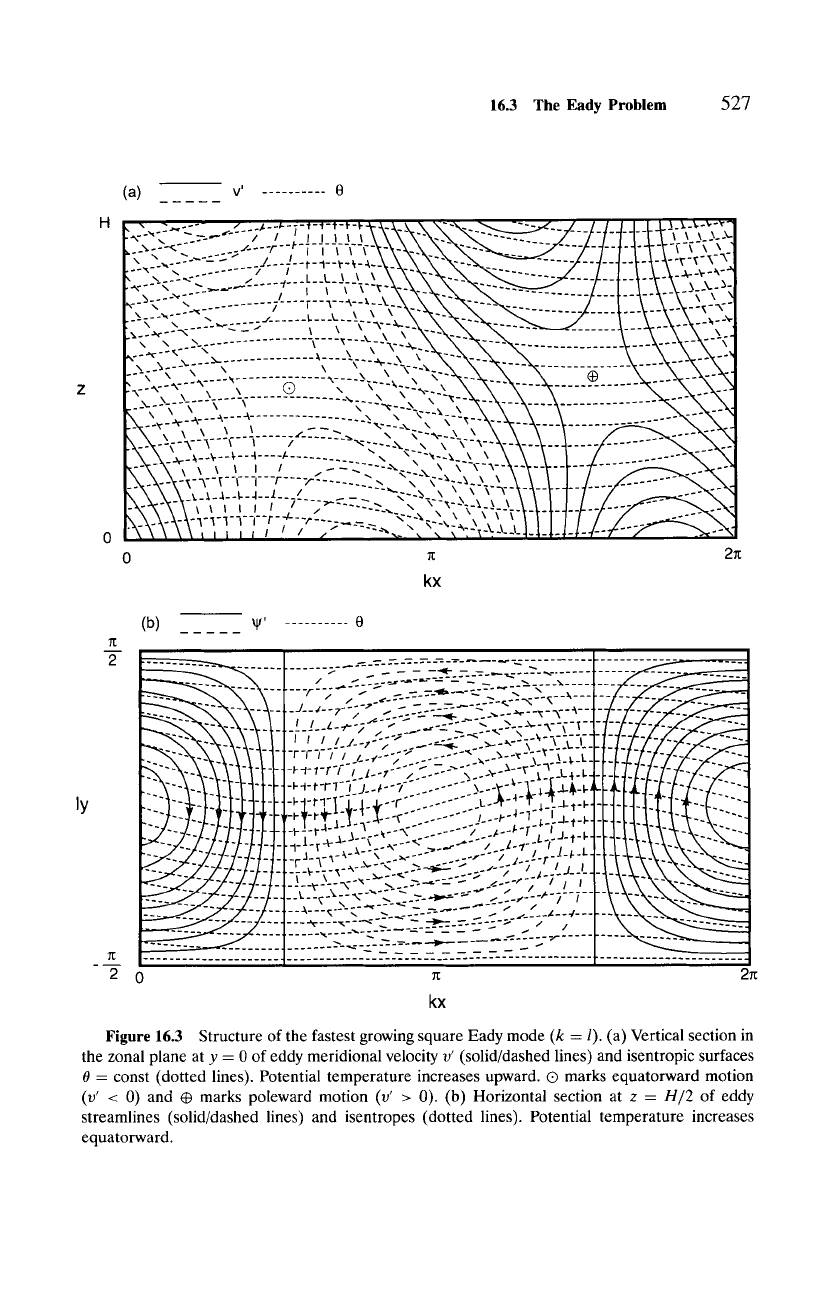
16.3 The Eady Problem 527
(a) v' - ......... 0
v'~-'~: ..... ~---y-,-;-,--c-<-~k-\-N-\-&~ --~--Z:I-I 1-7-~-_c-_"~.:Q~-1
,,_.,..~ ..... __,,___,__,_,__,_,_,__ _ --. - .............
,
"" \ --',.
........ /
./ L
L ~ \ \ ""-- ... " .....................
-V.-~--~"
k .... <
-_ ...........
7:t
:_.,.;.:I
--'~,"":-"_ ........... ~----r--~--~--~--~-.." "" - ......... " ............. -_ _-\ ~--
k,_.-. ..... .
.'
-- -,-,--,--,-,---,----, ..... 2:. "\'" r --~___ "'" "
0 rt 2rt
kx
/1:
2
(b)
V'
- .........
O
T
---~ ...... :, .... ---L:-S-L'--'~ " - -_...~Z__-" .........
---~---r ..... "~" --.-~, ..... --'-"-<--',"- - ....
/. / ," .... ='--:."-"_ _".~------<--m--'--"
V-f- .:'- - "- - ,";, ~, .-:..~-:-----~-~S.".--.-:~--~-~ --~--
-~-l-.'--l--L-+--~ ," _.-----:-=" .:...--~-<-'-.-~--C-_Y:
1--r-r-cT~ z.~--':": ....... "~.-~--~--'~'i"~-[-
-~ + + ~-rr';" l.-,-"';';..
:->-~'. :~- ~--~-'; ~: Z ~:L:
r-P -~-r-r~-T~s -~-'-/"" . ...... L-@-~'T l'_[.i.~-~,
I-I" -v 1-r 1"1-1: I. ~--r'": ....... ::L. J~-'-~7, Z-~ ,-v.
~-P-~l-~'-'~] ' -l---e'" - ..... i .-~-~-7 ~ ~j t-~
-
-'- 4-~" "~" - .... ---T" -~-
- "l- -
"~" +t r ~a_~._c.~- ~.~,. .... .~ .... ~-, r ~.,.~_~_~.
-1" .-v.-r-'- ,, x__C-~, -- -:--- ~-':~'~'7 ~ / ~ L
-r- -[- -~'- x----,'" ,--->" / _-~--- ....
.,I._ .... V_---N--~- 3.._:.=....=--'- ..-- .,.,, .,~,,ot . / l I
i---~--~-~:-"--"--- ":--='-'~'~':" -.:-,:- -~- 7"- 7 -"
t
.... "~---~'" ~ ~--..----~.~ ... ~ I ....
Z--4---
...... 9 -~- - - -'~.--"~'~ "" _ _ _- --"----Z.->" / /
........ ~, .... ',,,.-~ .... -=--- _ -- .-. ...-. ~___~,,. .....
_ >_ .,~ _ _ _ -~- - -'='- ,-.-- -...-l~-'-- .......
_m
2
0 rt
2rt
kx
Figure 16.3 Structure of the fastest growing square Eady mode (k = I). (a) Vertical section in
the zonal plane at y = 0 of eddy meridional velocity v' (solid/dashed lines) and isentropic surfaces
0 = const (dotted lines). Potential temperature increases upward. | marks equatorward motion
(v' < 0) and @ marks poleward motion (v' > 0). (b) Horizontal section at z =
H/2
of eddy
streamlines (solid/dashed lines) and isentropes (dotted lines). Potential temperature increases
equatorward.
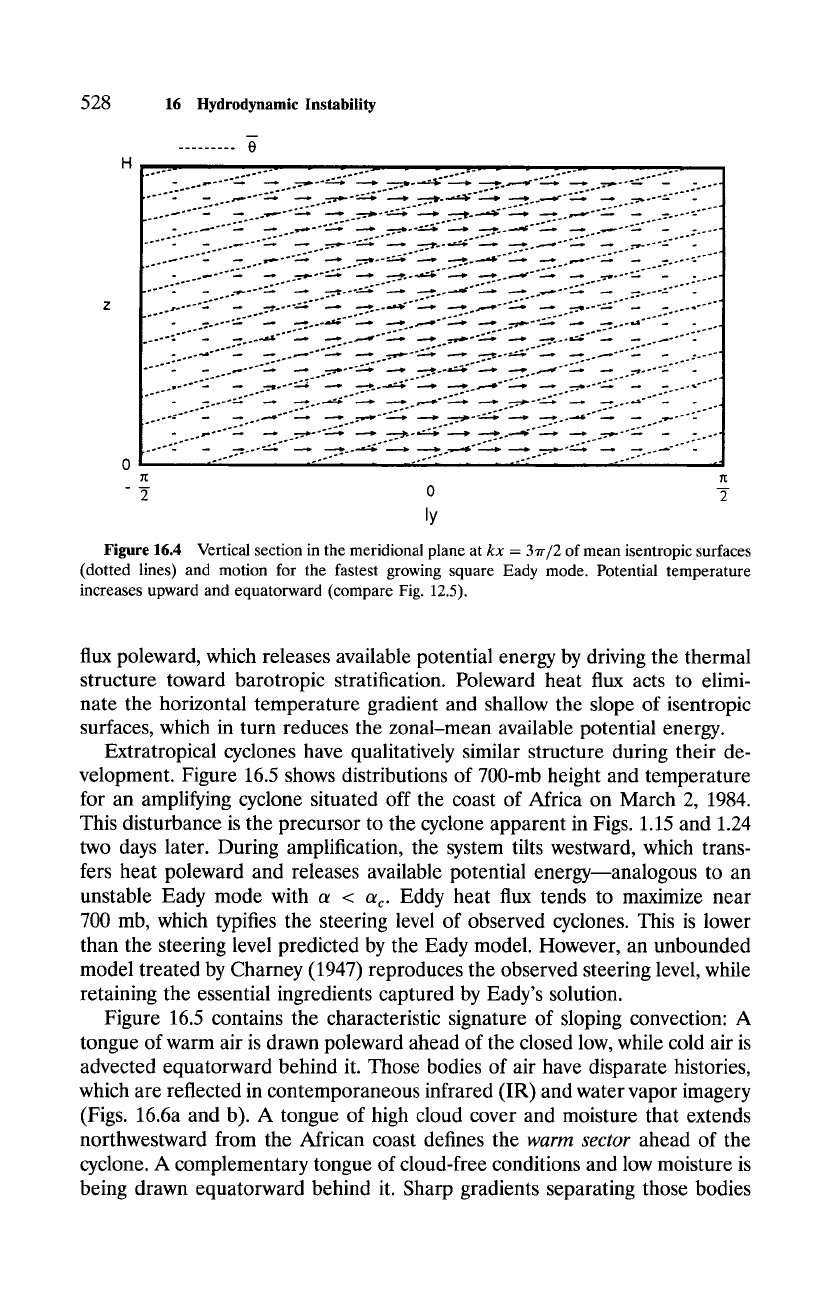
528
16
Hydrodynamic Instability
m
.......... 0
H
. ..o..- .... .., -.,, o~.,,,oO~ ~ __.~.~o--.r.:-~ ~ ..-.po..,.~~176 .-..,, .,,.,,-ooT.~ - .....
. ...,.---'.~ ...,, ..m,,..--_:~" ~ _.r~....,,,~r,"...-~ ~ .,.-~-~ ....,, _.,..-:.T, ~ _ . ..
..... "-" - .,,.---~'" ...- _.-.~,.~ .-.~.~176176 ~ .~,.--:.~" _.. ~ .... -~ .... .
Z ..... --=.'" -- ~ .... .=.z,'"_.., ...r:,...,,.~~ _...,,~ ...., ._,.--=.:-"_ _ ....----
.... . .. o~ .... ~ _.., _.~,,~ ~ ..rT~....~.z.~ ~ ~ ~ ..,..,~'~ ...,, ..~.o--~" .
...... ".~ .,, ._~.o~ _.., ..7~..o..,~.~ ~ ~ _..~~176 ~ ..~,~176 .,, _ ...,o-"
.... "." _ ~ .... ~ ._.,, .._~_......,,..~'....._~ ~ .,_..~'T.....~ ~ .-...=.,~-'-~.:-7, --4, ..., ....,,-'" -
0
-~
o 7
ly
Figure 16.4 Vertical section in the meridional plane at
kx
= 37r/2 of mean isentropic surfaces
(dotted lines) and motion for the fastest growing square Eady mode. Potential temperature
increases upward and equatorward (compare Fig. 12.5).
flux poleward, which releases available potential energy by driving the thermal
structure toward barotropic stratification. Poleward heat flux acts to elimi-
nate the horizontal temperature gradient and shallow the slope of isentropic
surfaces, which in turn reduces the zonal-mean available potential energy.
Extratropical cyclones have qualitatively similar structure during their de-
velopment. Figure 16.5 shows distributions of 700-mb height and temperature
for an amplifying cyclone situated off the coast of Africa on March 2, 1984.
This disturbance is the precursor to the cyclone apparent in Figs. 1.15 and 1.24
two days later. During amplification, the system tilts westward, which trans-
fers heat poleward and releases available potential energy--analogous to an
unstable Eady mode with c~ < a c. Eddy heat flux tends to maximize near
700 mb, which typifies the steering level of observed cyclones. This is lower
than the steering level predicted by the Eady model. However, an unbounded
model treated by Charney (1947) reproduces the observed steering level, while
retaining the essential ingredients captured by Eady's solution.
Figure 16.5 contains the characteristic signature of sloping convection: A
tongue of warm air is drawn poleward ahead of the closed low, while cold air is
advected equatorward behind it. Those bodies of air have disparate histories,
which are reflected in contemporaneous infrared (IR) and water vapor imagery
(Figs. 16.6a and b). A tongue of high cloud cover and moisture that extends
northwestward from the African coast defines the
warm sector
ahead of the
cyclone. A complementary tongue of cloud-free conditions and low moisture is
being drawn equatorward behind it. Sharp gradients separating those bodies
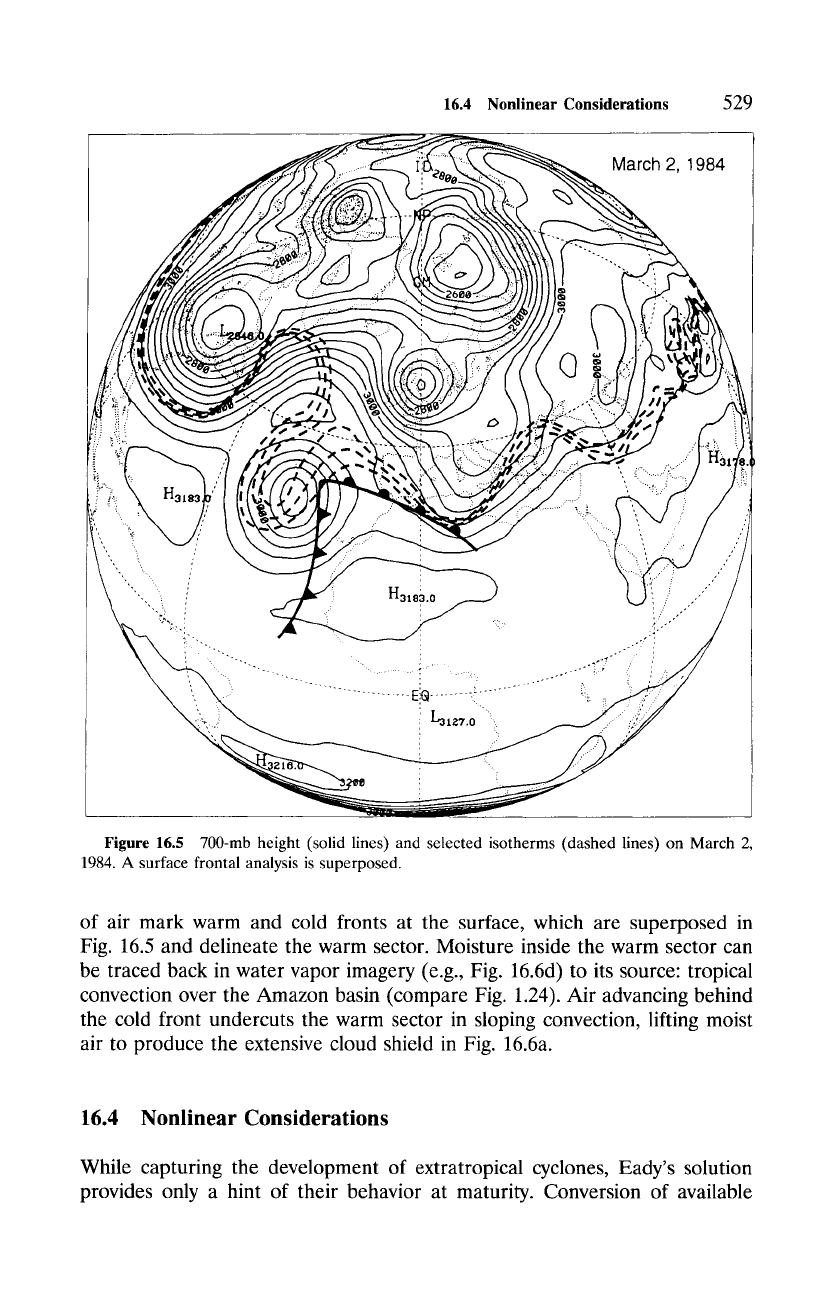
16.4 Nonlinear Considerations
529
March 2, 1984
""-..,
,, ......,..:
......... ~i...}::.ill.... - ....... -~, ......" .....
, .~.. /
H3183.o ~ i
..:.
,
...
?... -... .
. -.. :.. .
"...... "._..... _. _ '" ..................... ~"" ......... .. ...... -::..: .. -..... :...
::- - ..................... E,~ ........ ~! .............. ~:
....
".. ..
.
, .
~
~ ', .~.
Figure 16.5 700-mb height (solid lines) and selected isotherms (dashed lines) on March
2,
1984. A
surface frontal analysis is superposed.
of air mark warm and cold fronts at the surface, which are superposed in
Fig. 16.5 and delineate the warm sector. Moisture inside the warm sector can
be traced back in water vapor imagery (e.g., Fig. 16.6d) to its source: tropical
convection over the Amazon basin (compare Fig. 1.24). Air advancing behind
the cold front undercuts the warm sector in sloping convection, lifting moist
air to produce the extensive cloud shield in Fig. 16.6a.
16.4 Nonlinear Considerations
While capturing the development of extratropical cyclones, Eady's solution
provides only a hint of their behavior at maturity. Conversion of available
